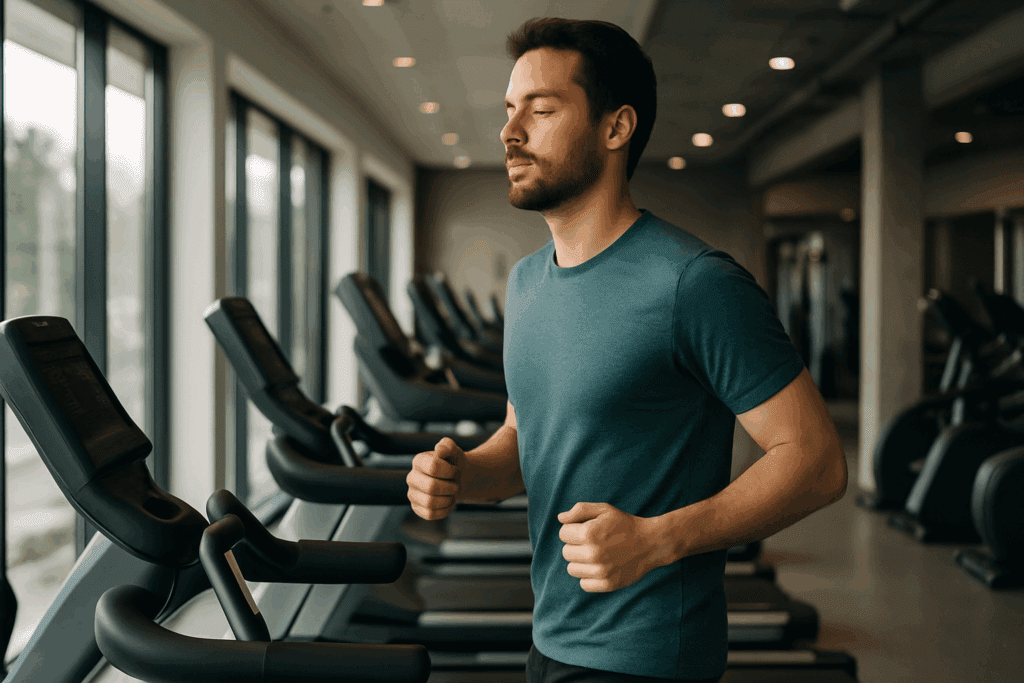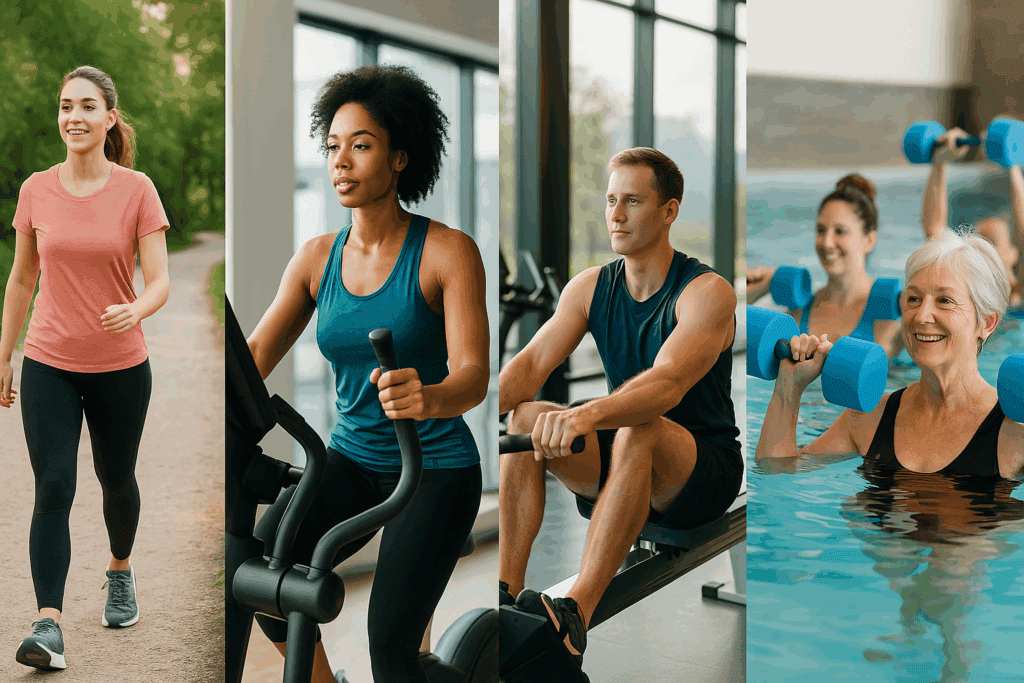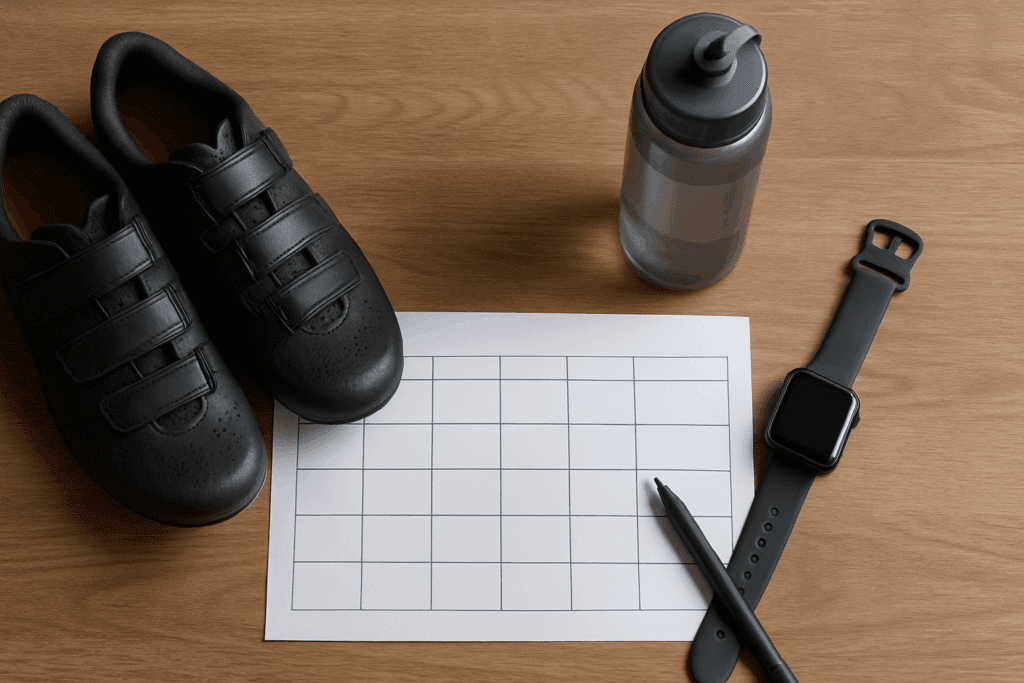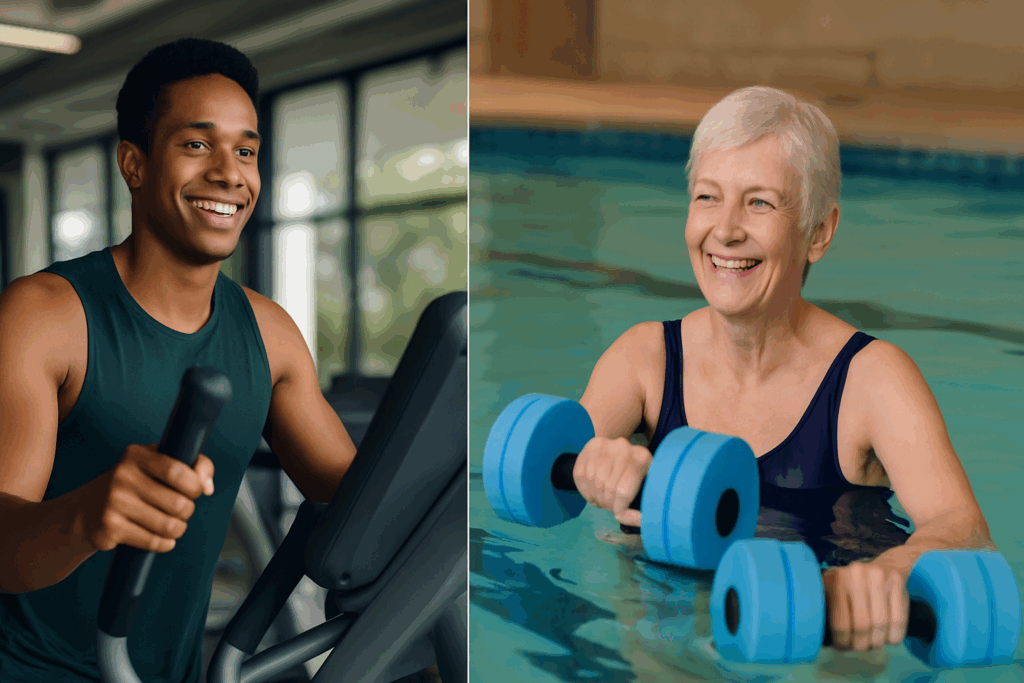Introduction: Why Low Impact Cardio Matters for Modern Fitness
In today’s evolving fitness culture, the emphasis on longevity, sustainability, and joint-friendly movement has sparked widespread interest in low impact cardiovascular exercises. While high-intensity training often dominates headlines for rapid transformation, low impact cardio offers a quietly powerful alternative for those seeking to improve endurance and overall performance without the toll on their joints. These exercises are particularly relevant for individuals recovering from injury, older adults aiming to maintain mobility, and athletes integrating restorative sessions into rigorous training programs. Contrary to outdated assumptions, low impact doesn’t mean low intensity. The best low impact cardio exercises can challenge the cardiovascular system, boost stamina, and enhance muscular endurance, all while minimizing stress on the knees, hips, and spine.
You may also like: How to Increase Stamina and Endurance Naturally: Smart Training Tips and Nutrition Habits That Support Cardiovascular Fitness
Scientific studies increasingly support the benefits of low impact cardio training for both general health and athletic performance. A well-structured light aerobic workout can elevate heart rate, improve blood flow, and enhance respiratory efficiency, contributing to long-term cardiovascular resilience. Additionally, by reducing the risk of overuse injuries, these workouts allow for consistent exercise participation, which is one of the most important factors in building endurance and maintaining performance over time. In this article, we will explore the physiological advantages, practical applications, and top forms of non impact cardio exercises that help you go the distance—without breaking down your body in the process.

Understanding the Science Behind Low Impact Cardiovascular Exercises
At its core, low impact cardio refers to movements that keep at least one foot on the ground or minimize jarring forces on the joints. Unlike high-impact activities such as running or jumping, which involve repetitive impact and abrupt transitions, low impact cardiovascular exercises prioritize fluid motion and controlled loading. These characteristics are essential for joint health, especially among individuals with osteoarthritis, post-surgical rehabilitation, or biomechanical imbalances. Research from institutions like the American College of Sports Medicine underscores how low impact cardio training can deliver substantial cardiovascular and metabolic benefits without the degenerative wear and tear associated with more aggressive modalities.
Physiologically, low impact cardio stimulates the same core systems as high-impact training: it elevates heart rate, increases oxygen uptake, and promotes mitochondrial density in muscle cells. What differentiates it is the way the body absorbs and distributes mechanical load. This allows users to train for longer durations, with less risk of inflammation or delayed onset muscle soreness. Furthermore, when integrated intelligently into a broader training regimen, these sessions serve as excellent tools for active recovery, promoting tissue repair while keeping the cardiovascular system engaged.
It is also worth noting that the hormonal response to low impact cardio—especially when sustained for longer durations—can be highly beneficial for stress regulation and metabolic health. Activities such as cycling, rowing, and elliptical training may trigger the release of endorphins and reduce cortisol levels, enhancing both mood and cognitive function. Thus, for individuals seeking to optimize both performance and wellness, incorporating light aerobic workouts is a highly effective strategy. Whether you are an elite athlete cycling through training blocks or someone returning to movement after a sedentary period, these exercises offer a powerful blend of safety, scalability, and cardiovascular challenge.

Reevaluating Intensity: The Power of a Light Aerobic Workout
The notion that a workout must be grueling to be effective is one of the most enduring myths in fitness. While intensity has its place, sustained aerobic activity at a light to moderate level can build endurance with remarkable efficiency. A well-designed light aerobic workout can keep the heart rate within the fat-burning zone while improving mitochondrial function and capillary density—both essential components of stamina. More importantly, it allows for consistency, which is a key predictor of long-term fitness outcomes.
From a training perspective, the goal of a light aerobic workout isn’t to max out effort, but rather to maximize time under tension within an aerobic threshold. This approach is especially useful for athletes during base-building phases or individuals who are new to fitness and need a gradual, sustainable entry point. Moreover, the moderate intensity associated with these workouts supports cardiovascular improvements without placing excessive strain on the musculoskeletal system. The result is improved aerobic capacity, better oxygen utilization, and a stronger, more resilient heart.
There is also a cognitive component to consider. Light cardio sessions can enhance mental clarity and emotional regulation by promoting parasympathetic nervous system activity. This makes them particularly valuable for people managing high levels of stress or seeking to improve sleep quality. Unlike high-impact sessions that may leave the nervous system overtaxed, light aerobic workouts help recalibrate internal rhythms, leaving participants feeling energized rather than depleted. The benefits extend far beyond the gym, influencing productivity, mood, and overall quality of life.

Exploring the Best Low Impact Cardio Exercises for Endurance
Among the most accessible and effective forms of low impact cardio are brisk walking, stationary cycling, elliptical training, rowing, and water aerobics. Each of these options engages large muscle groups in rhythmic patterns, stimulating the heart and lungs while minimizing ground reaction forces. Brisk walking, for example, may seem deceptively simple, but research shows it can produce significant improvements in cardiovascular health, particularly when performed on varied terrain or with light inclines. When done consistently, it becomes one of the best low impact cardio workouts for maintaining cardiovascular integrity over time.
Stationary cycling is another standout, often used in both rehabilitation and performance settings. It allows for joint-friendly movement with customizable resistance, making it easy to tailor intensity to personal fitness levels. Whether used in a spin class or as part of a solo routine, cycling is an excellent low impact cardio training method for building leg endurance and enhancing aerobic power. Elliptical machines, similarly, offer full-body engagement while preserving joint health. Their adjustable resistance and incline settings allow for progressive overload without the pounding stress associated with treadmill running.
Rowing deserves special attention for its capacity to integrate cardiovascular endurance with muscular strength. A well-executed rowing stroke engages the legs, core, and upper body in a smooth, cyclical motion, making it a top contender for the best low impact cardio exercises available. Water aerobics and aquatic jogging, meanwhile, take advantage of water’s natural resistance and buoyancy to deliver non impact cardio exercises ideal for injury recovery or cross-training. The gentle yet effective nature of these modalities makes them uniquely beneficial for populations ranging from pregnant women to aging athletes.

Designing a Sustainable Low Impact Cardio Training Program
Creating an effective low impact cardio training regimen begins with identifying clear goals. Are you aiming to build endurance, recover from an injury, improve heart health, or support weight management? The answer will influence the duration, frequency, and type of workouts you choose. A general guideline for cardiovascular health is to engage in at least 150 minutes of moderate-intensity aerobic exercise per week, as recommended by the Centers for Disease Control and Prevention. However, this can be adapted based on individual needs and preferences.
Consistency is the cornerstone of any successful training plan. By incorporating good low impact cardio exercises into your weekly schedule, you can gradually build stamina without the setbacks that come from injury or burnout. It’s helpful to vary modalities to prevent overuse and maintain motivation. For instance, you might alternate between swimming, cycling, and rowing across different days. This cross-training approach keeps the body guessing while ensuring that all major muscle groups are addressed.
Progression should also be part of the plan. This might involve increasing the duration of your sessions, adding resistance, or incorporating interval-style variations within a light aerobic workout. Listening to your body is crucial—pushing too hard, even with low impact options, can lead to fatigue or overtraining. Using heart rate monitors or perceived exertion scales can help guide intensity, keeping workouts effective yet sustainable. Recovery strategies, including stretching, hydration, and adequate sleep, further support long-term progress.

Integrating Low Impact Cardio with Performance Enhancement Goals
For athletes and performance-focused individuals, low impact cardio is far more than a recovery tool. When programmed strategically, it can enhance aerobic base, accelerate recovery between high-intensity sessions, and improve movement efficiency. Endurance sports like triathlon, distance cycling, or rowing rely heavily on aerobic capacity, and non impact cardio exercises can be used to build volume without increasing injury risk. This is particularly useful during training deload weeks or post-competition recovery periods.
In strength and conditioning programs, low impact cardiovascular exercises can serve as active recovery or general physical preparedness (GPP) work. For example, a bodybuilder might use incline walking or cycling on off days to promote blood flow and aid in nutrient delivery to muscles, without compromising joint integrity. Similarly, sports teams often include elliptical or pool-based sessions during in-season training to maintain conditioning while managing cumulative fatigue.
Low impact cardio also plays a role in neuromuscular adaptation. Movements like rowing or elliptical training promote coordinated motor patterns across multiple joints and muscle groups. This enhances proprioception, balance, and movement economy—factors that contribute significantly to athletic performance. When integrated thoughtfully, the best low impact aerobic exercise options not only support cardiovascular function but also contribute to agility, stability, and overall athletic resilience.

Overcoming Myths and Misconceptions About Low Impact Workouts
Despite growing recognition, low impact cardio still suffers from certain misconceptions. One common myth is that these workouts are only suitable for beginners or seniors. In reality, some of the best low impact cardio workouts are used by elite athletes as part of their regular training routines. The effectiveness of an exercise is not determined solely by the amount of sweat it produces, but by how well it meets physiological needs and training goals. Even moderate-intensity sessions can lead to substantial gains when programmed intelligently.
Another misconception is that low impact equals low calorie burn. While it’s true that high-intensity workouts can torch calories quickly, the sustained nature of a light aerobic workout often results in a comparable or greater cumulative energy expenditure over time. More importantly, low impact cardio promotes metabolic flexibility—the body’s ability to efficiently switch between fat and carbohydrate as fuel sources. This makes it particularly valuable for endurance athletes, metabolic health, and sustainable weight management.
Finally, there is a tendency to undervalue the mental and emotional benefits of low impact movement. The rhythmic, meditative nature of good low impact cardio exercises can help reduce anxiety, regulate mood, and improve focus. These psychological advantages are often overlooked in favor of more measurable outcomes like heart rate or VO2 max. Yet they play a crucial role in adherence, consistency, and overall quality of life. By shifting the narrative around these workouts, we can better appreciate their role not just in fitness, but in holistic well-being.
Frequently Asked Questions: Boosting Endurance with Low Impact Cardio
What are some innovative ways to make low impact cardiovascular exercises more engaging?
To make low impact cardiovascular exercises more engaging, variety and creativity are essential. Integrating technology, such as interactive fitness apps, virtual cycling tours, or rowing simulators, can transform routine sessions into immersive experiences. For those who enjoy social interaction, joining a low impact cardio training group or participating in community fitness challenges can add accountability and excitement. Some individuals find that incorporating music, tempo-based playlists, or even dance-inspired routines turns a typical light aerobic workout into an enjoyable rhythm-based session. Gamifying workouts by tracking personal records or completing themed weekly goals also keeps the momentum alive without needing to increase intensity.
Can low impact cardio training enhance cognitive function and mental performance?
Yes, recent studies suggest that consistent low impact cardio training can significantly enhance brain function. Engaging in activities like brisk walking or moderate cycling boosts blood flow to the brain, improving memory, focus, and mental clarity. Non impact cardio exercises that include coordinated movements, such as rowing or elliptical sessions, may stimulate neural plasticity by requiring simultaneous motor and cognitive processing. These benefits are particularly valuable for older adults looking to preserve cognitive function and for professionals seeking mental sharpness without the physical fatigue of high-intensity training. In this way, good low impact cardio exercises support not only physical endurance but also sustained intellectual performance.
What are some effective ways to combine strength training with the best low impact cardio?
Hybrid routines that alternate between resistance and cardio intervals are an efficient way to blend strength training with the best low impact cardio exercises. For example, pairing rowing machine intervals with bodyweight squats or resistance band work creates a full-body circuit that maintains aerobic intensity while building muscle. Another approach involves using tools like kettlebells or medicine balls in a circuit-style light aerobic workout that limits joint impact. Functional movements such as step-ups, modified burpees, and push-ups can be combined with non impact cardio exercises like stationary biking to create a balanced, strength-focused routine. This combination enhances metabolic conditioning, improving both muscular endurance and cardiovascular health in a joint-friendly format.
Are there specific non impact cardio exercises suitable for people with chronic conditions like arthritis or fibromyalgia?
Absolutely. For individuals managing arthritis, fibromyalgia, or other chronic conditions, water-based activities are often among the best low impact aerobic exercise options. Aquatic workouts minimize gravitational pressure on joints while allowing full-body movement against gentle resistance. Chair cardio, which involves seated low impact cardiovascular exercises, can be particularly useful during flare-ups or for those with limited mobility. Recumbent bikes offer another accessible solution, enabling light aerobic workouts that support stamina without worsening joint pain. With proper medical guidance, these approaches can help maintain fitness, improve circulation, and manage symptoms over time.
How can someone track progress when doing low impact cardio training?
Progress tracking during low impact cardio training requires a combination of qualitative and quantitative methods. Using heart rate monitors helps ensure you’re working within your target aerobic zone, while fitness watches can log distance, pace, and duration. Subjective markers such as reduced perceived exertion during previously challenging sessions also indicate cardiovascular improvement. Logging workouts in a digital journal allows you to observe trends and make adjustments over time. For individuals focused on the best low impact cardio workouts, improvements in recovery rate, mood, and sleep patterns are equally valuable indicators of progress.
What role does breathing technique play in optimizing a light aerobic workout?
Proper breathing technique is often overlooked but plays a crucial role in the effectiveness of a light aerobic workout. Deep diaphragmatic breathing enhances oxygen intake and carbon dioxide expulsion, improving endurance and delaying fatigue. Coordinated breathing patterns—such as inhaling for three steps and exhaling for two during walking—can stabilize rhythm and increase efficiency. In non impact cardio exercises like rowing or cycling, syncing breath with movement helps regulate pace and conserve energy. Additionally, mindful breathing reduces sympathetic nervous system activation, lowering stress and promoting a state of calm that enhances overall performance. Incorporating breath training into your regimen adds another layer of control and precision.
Can the best low impact cardio exercises support weight loss goals effectively?
Yes, when combined with a well-balanced diet and consistent routine, the best low impact cardio exercises can effectively support weight loss. While they may not produce the calorie spikes of high-intensity workouts, their longer duration and sustainability lead to substantial cumulative energy expenditure. More importantly, they promote fat oxidation and metabolic flexibility—key elements in long-term fat loss. For individuals who are overweight or managing conditions like PCOS or thyroid disorders, low impact cardio training offers a sustainable way to improve insulin sensitivity and support hormonal balance. Over time, doing some light cardio daily helps establish habits that are both effective and maintainable for a diverse range of body types.
How does recovery differ after non impact cardio exercises compared to high-impact training?
Recovery following non impact cardio exercises is typically faster and less taxing on the musculoskeletal system. Since these activities minimize joint strain and muscle trauma, there is less need for extended downtime or aggressive recovery protocols. This allows for more frequent training sessions, which is advantageous for endurance building. Additionally, low impact cardio training supports active recovery by enhancing circulation, which aids in flushing out metabolic byproducts like lactic acid. In contrast, high-impact workouts often require longer recovery due to microtears and inflammation. Therefore, alternating intense sessions with low impact days can promote more consistent overall progress without compromising performance.
Are there any psychological benefits unique to low impact cardio routines?
Low impact cardio routines offer unique psychological benefits, particularly in fostering mindfulness and emotional stability. The repetitive and rhythmic nature of these workouts promotes a meditative state that can reduce anxiety and depressive symptoms. Because there is less physical strain, participants can focus more on breath, posture, and internal cues, deepening body awareness. This mindful movement enhances the brain’s reward response, creating positive reinforcement that supports consistency. Whether it’s a quiet walk in nature or a steady elliptical session, doing some light cardio regularly cultivates a sense of control and mental clarity, helping to manage stress in daily life.
What emerging trends are shaping the future of low impact cardio training?
The future of low impact cardio training is being shaped by technological innovations and a shift toward holistic wellness. Wearable devices now provide real-time biofeedback, helping users fine-tune effort levels during the best low impact cardio workouts. Virtual reality and interactive gaming platforms are transforming traditional light aerobic workouts into immersive experiences, appealing to younger demographics and tech-savvy exercisers. There is also a growing emphasis on accessibility, with more programs designed for adaptive athletes and aging populations. Trends in longevity science have reinforced the role of low impact cardiovascular exercises in promoting cellular health and mobility well into later life. As the fitness world embraces personalization and inclusivity, non impact cardio exercises are poised to become a central part of mainstream training paradigms.
Conclusion: Embracing Low Impact Cardio for Lifelong Endurance and Performance
As the science of movement continues to evolve, so too must our approach to training. Low impact cardiovascular exercises offer a sustainable, joint-friendly, and performance-enhancing alternative to traditional high-impact routines. Whether you are looking to build stamina, recover from injury, or enhance athletic capacity, the best low impact cardio exercises can help you meet your goals without sacrificing long-term health. They are versatile, effective, and adaptable to nearly every fitness level and life stage.
When designed and executed with intention, a light aerobic workout is not merely a compromise—it is a cornerstone of intelligent training. From elliptical machines to water aerobics, from rowing to brisk walking, the spectrum of non impact cardio exercises available today is both diverse and empowering. These movements build not only physical endurance but also mental resilience, supporting the kind of sustainable fitness that lasts a lifetime.
Incorporating the best low impact cardio workouts into your routine allows you to push boundaries without crossing them. You can challenge your cardiovascular system, improve metabolic health, and enhance muscular efficiency while safeguarding the joints and ligaments that carry you through life. In an era that increasingly values longevity, functionality, and holistic health, low impact cardio training is no longer optional—it’s essential. So lace up, dive in, or hop on the bike. It’s time to do some light cardio—and go the distance without the impact.
Was this article helpful? Don’t let it stop with you. Share it right now with someone who needs to see it—whether it’s a friend, a colleague, or your whole network. And if staying ahead on this topic matters to you, subscribe to this publication for the most up-to-date information. You’ll get the latest insights delivered straight to you—no searching, no missing out.
Further Reading:
What’s the Difference Between Endurance and Stamina?
Try This: 6 Low-Impact Cardio Exercises in 20 Minutes or Less
20 cardio exercises to do at home with minimal equipment, from beginner to advanced

